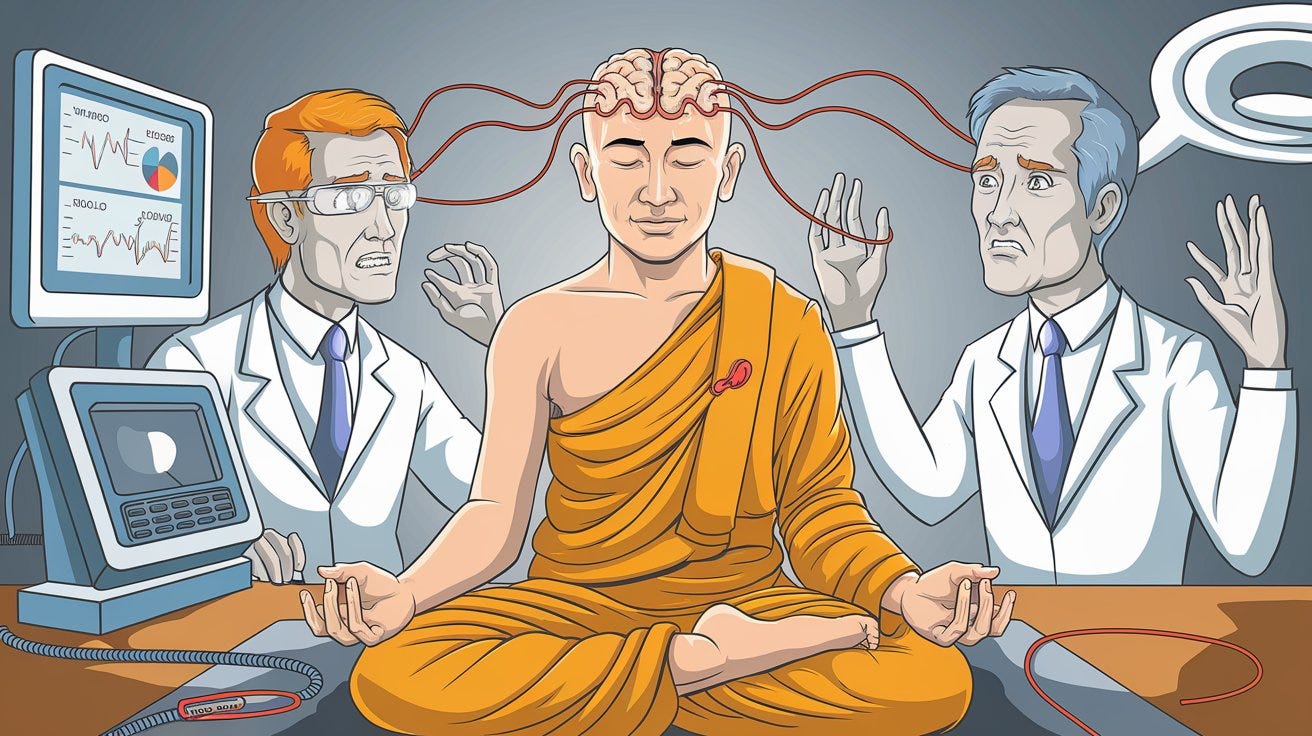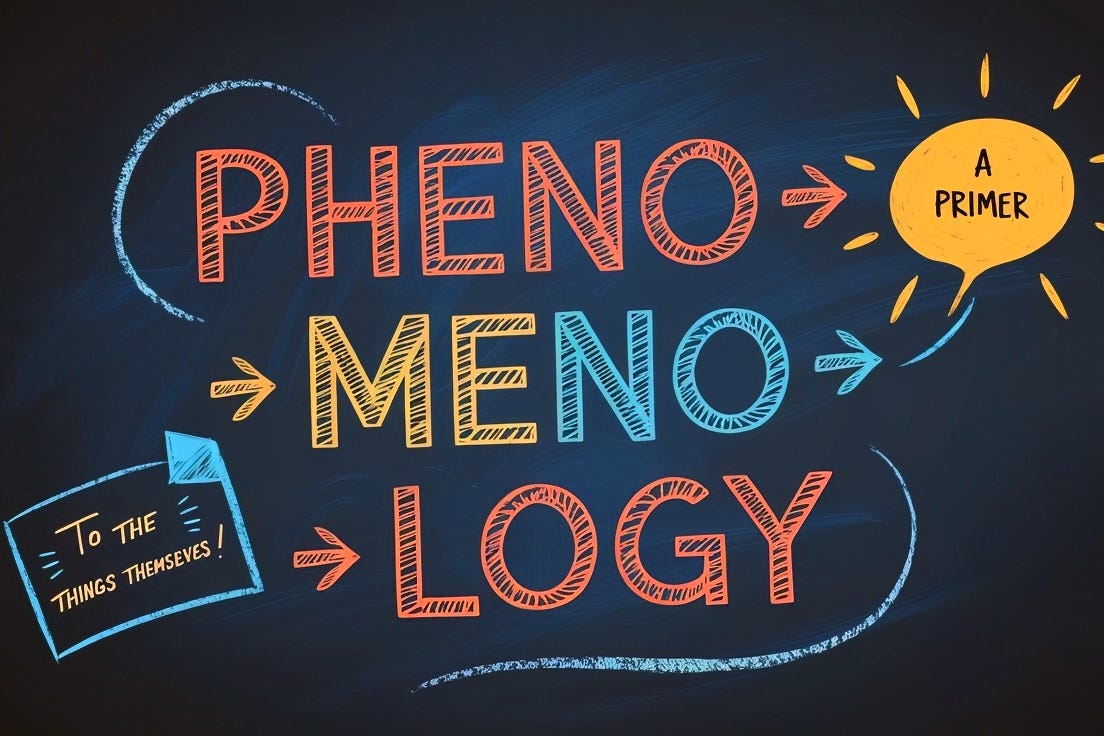Etymology
What exactly is the appeal of etymology? I am fascinated by tracking meanings down throughout the ages. You can see meaning accumulating, taking a turn, and evolving over time. Concepts get grafted onto new ideas, and sometimes they are even forgotten. Language is not only the house of Being, as Heidegger says, but it’s also a graveyard for the most interesting relics produced by thought. Indulge me for a hot minute:
The word “phenomenology” comes from the ancient Greek words:
phaino
-menon, present participle in the middle passive voice
logos is well known
The first word, phaino, means “to appear” or “to bring to light.” It is the same word used by Socrates when he names himself Phainetre, meaning a midwife of ideas, he who brings ideas to light in the Theatetus, a dialogue on the nature of knowledge.
-menon refers to something being or happening, with the middle voice indicating that it’s happening reflexively, to itself. In this context, appearances are manifesting on their own, not because someone is making them appear. Here, phenomena reveal themselves to an observer, often with a quality of natural unfolding or self-presentation.
Finally, logos: logic, but also reason, word, speech, principle, order. In the case of phenomenology, it might be something like the study of organizing principles for manifesting appearances.
(Truth, light/enlightenment, seeing, manifestation, and knowledge have been conceptually linked about as far back as we can go - good story for another time... now back to phenomenology. )
History
While the term “phenomenology” has been used in various disciplines, its contemporary significance in philosophy can be traced back to the early 19th Century. G.W.F. Hegel uses the term in the title of his Phenomenology of Spirit (1807) and the psychologist Franz Brentano used the term to mean "descriptive psychology" in his influential 1874 work, Psychology from an Empirical Standpoint. Edmund Husserl, the father of Phenomenology as a philosophical school and method, takes the term from both Hegel and Brentano to describe his innovative "science of consciousness," ushering in the era of Phenomenology as we understand it today. Husserl's Phenomenology studies the structures of consciousness and the ways in which phenomena are experienced.
In the hands of Martin Heidegger, Husserl’s student and protege, the Greek root phaino takes on profound philosophical significance in relation to Phenomenology. For Heidegger, phenomenology is not just about "what appears" in the sense of surface-level perception, but more fundamentally about "that which shows itself," or disclosure. Being discloses itself as truth, aletheia. Heidegger’s phenomenology in Being and Time (1927) pivots away from knowledge/epistemology and towards the study of existence and Being, ontology. He called it an existential phenomenology, to distinguish it from Husserl’s method.
Emmanuel Levinas brought a copy of Heidegger’s Being and Time into France in 1931, whereupon existential phenomenology was shortened to existentialism in the French context. Jean-Paul Sartre has been it’s most visible adopter. His version of phenomenology emphasizes the role of individual consciousness and personal freedom in creating meaning, focusing on the concepts of authenticity and of "being-for-itself" in a world perceived as inherently meaningless. His short and readable essay “Existentialism is a Humanism” (1946) is the best place to go for an explanation of Sartrean existentialism, and I recommend Nigel Warburton’s guide published in Philosophy Now: “A student’s guide to Jean-Paul Sartre’s Existentialism and Humanism.”
Existentialism was incredibly popular and became the banner under which not only Sartre, but thinkers as diverse as Simone de Beauvoir, Maurice Merleau-Ponty, Franz Fanon, and more gained recognition. Beauvoir's thought examines how social and cultural structures shape the female experience and identity, but she draws on a pretty wide array of writers and traditions. Maurice Merleau-Ponty's version of phenomenology returns to Husserl’s engagement with psychology but stresses the embodied nature of human consciousness and perception, arguing that our understanding of the world is intrinsically linked to our physical bodies and sensory experiences. Frantz Fanon's version of phenomenology explores the psychological and existential impacts of colonialism and racism, focusing on how these forces shape identity and lived experiences through the concepts of alienation and dehumanization.
These are some of the most well known figures from that time and place. Existentialism reaches Latin America where a very successful and independent scene emerges in the 1950’s, and the United States, where 1950’s beatniks and later 1960’s hippies took up existentialist themes of freedom and individualism. I write about this in my series on American Individualism: The Production of American Individualism.
“To the Things Themselves!”
The motto of Phenomenology is “to the things themselves!” This, in reaction against two basic tendencies: scientific objectivity and psychologism. Science establishes itself as an authority in knowledge production, but with its abstract, specialized and technical language, scientific knowledge is usually out of reach for most people, and its truths fail to reach lived experience. The scientist tells us about atoms, and other theoretical particles, as the underlying reality of the world, but we don’t experience atoms - heck, we can’t even see them.
My favorite illustration of this are scientific studies where they hook up a meditating monk to a machine that could tell scientists what was going on in the mind of the monk as he meditated.1 However, the scientific knowledge produced through this experiment got nowhere close to the experience of meditation. Turns out, objective scientific measurements cannot get at subjective human experiences, which also means that science is not about getting at those experiences but about something else... Phenomenology does seek to get at that experience, in some methodical way.
Psychologism has the opposite problem in that it reduces knowledge to subjective mental processes. The thing appears to you in its red-ness, but who is to say that what you see and call “red thing” is the same as another’s experience of either that thing, or its red-ness. Psychologism questions the universality and objectivity of knowledge by suggesting that personal perceptions—such as seeing a "red thing"—might vary from person to person. This challenges the idea that there can be a consistent, shared understanding of concepts like "red-ness," leading to skepticism about the objectivity and universality of our experiences and knowledge. Husserl rejects this on the belief that truth and meaning must have objective structures that transcend individual psychology.
So, “to the things themselves!” is a call to return to experience itself, to the phenomena and to what appears to us, as the basis for knowledge. But now we are looking for the underlying, shared structures that make our experiences possible. Everything that we know, as humans, we know through out perceptive abilities - this includes our five senses (perception), apperception (the interpretation of sensory information based on past experiences and knowledge) and the more intellectual intuition, where we grasp the essence of something beyond mere sensory input. For example, a perfect circle does not exist anywhere on earth, but we can intuit a perfect circle that exists as a mathematical entity. We love the emphasis on embodied perception and apperception, because it means that knowledge is embodied and situated. More on this later…
Phenomenology seeks to reconnect thinking to everyday experience, and with the ways the world appears to us, not just through scientific abstraction or psychological interpretation, but through a first-person, rigorous analysis of phenomena. The goal is to reveal the structures of subjectivity that allows us to know, or the condition for the possibility of knowledge.
An Exercise In Phenomenology
Want to give phenomenology a try? Find a place where you feel comfortable —whether it's outside in nature or in a cozy spot in your living space. Sit down, relax, and let yourself be present in the moment. Don’t decide right away what to focus on; allow your curiosity to naturally guide you. As you sit quietly, something will draw your attention — a sound, a texture, an object, or a specific part of your surroundings. Whatever it is, let it capture your focus.
Now, with your attention fully on this thing, begin to observe it closely. Set aside any prior knowledge or assumptions you have about it. Forget its name, its purpose, or how you’ve used or experienced it before. Simply notice how it appears to you in this moment. What are its details? How does it look, sound, or feel? Does the light shift on it in any particular way? How does its presence feel in relation to you?
As you observe, pay attention not just to the object but to your own perception of it. Notice how your senses engage with it and how your awareness of it changes as you stay with it. Ask yourself: what is this thing, as it reveals itself to me right now? What does it seem to be for me, in this specific moment of observation? Allow yourself to become absorbed in the simple act of seeing, hearing, or touching, letting your experience unfold naturally.
Finally, reflect on the connection between your perception and the object’s presence. What is it about this thing that makes it what it is, in your experience? Without overthinking or analyzing, just notice the essence of its being as it reveals itself. Let this experience of “seeing the thing itself” stay with you, as an example of how ordinary encounters can take on new depth when observed phenomenologically.
Phenomenology In Practice
If you are a visual artist, you might recognize this process as that of learning to see, often put to good use while learning to sketch. Sketching can be approached as a phenomenological exercise. Whatever your skill level, try doing this as you sketch the thing and the scene it is in. It is one of the cheapest and most rewarding forms of entertainment, learning how to see and how to use your perceptive abilities with intentionality. Try it out, let me see your sketches!
Of course, you can also do this with language: write your way through the experience, then set it aside and come back to it later or the next day. You will get better and better at not only seeing and noticing things, but expressing how things appear to you through perception, apperception, and intuition. And disentangling these as well…
To Be Continued…
Numerous studies have been conducted on the neurological and physiological effects of meditation on monks, such as those by Dr. Richard Davidson and Matthieu Ricard, which involve measuring brain activity through methods like fMRI and EEG. These studies aim to bridge the gap between external observations and internal experiences.





This took me a few tries to read. There are a lot of new concepts here. My takeaway is this—phenomenology is the west independently rediscovering the eastern practices of meditation. The practice you describe at the very end is, to my understanding, equivalent to meditation.
From the Dalai Lama’s book, a Universe in a Single Atom:
“People often understand meditation to refer simply to an emptying of the mind, or a relaxation practice, but that is not what I mean here. The practice of gom does not imply any mysterious or mystical state or ecstasy open only to a few gifted individuals. Nor does it entail non-thinking or the absence of mental activity. The term gom refers both to a means, or a process, and to a state that may arise as a result of the process. I am concerned here primarily with gom as a means, which implies a rigorous, focused, and disciplined use of introspection and mindfulness to probe deeply into the nature of a chosen object. ”
I’d recommend giving that book a read, especially Chapter 7 “Toward a Science of Consciousness” if you have the chance. Maybe you could do a compare and contrast in the future?
Interesting article. Thanks very much for sharing it!